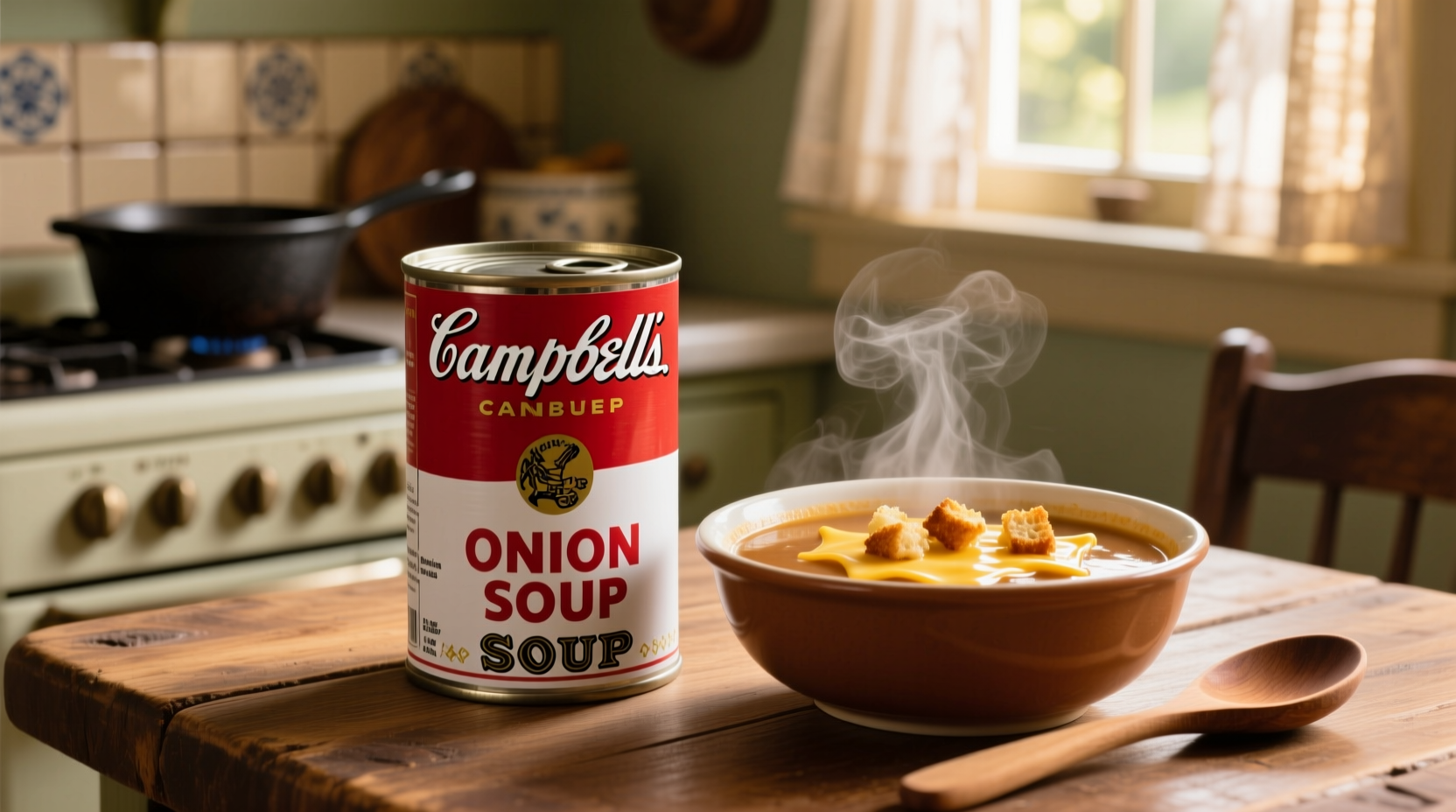For generations of American home cooks, Campbell's Condensed Onion Soup has been a pantry staple that bridges the gap between authentic French onion soup techniques and weeknight cooking realities. This iconic product delivers consistent onion flavor without the labor-intensive caramelization process required for traditional recipes, making it particularly valuable for time-pressed households seeking depth of flavor.
Understanding Campbell's Onion Soup Evolution
While French onion soup dates back to 18th century Parisian taverns, Campbell's version emerged during America's canned food revolution. The condensed format—removing water to reduce shipping costs—made gourmet flavors accessible to average households. Our timeline reveals key milestones:
| Year | Development | Significance |
|---|---|---|
| 1920 | Original condensed onion soup launch | First commercially available condensed version |
| 1940s | Post-WWII recipe booklet distribution | Established as primary ingredient for "onion soup dip" |
| 1970s | "Golden Mushroom" variant introduction | Expanded flavor profile options |
| 2010s | "Simpler Nutrition" reformulation | Removed artificial ingredients, reduced sodium by 30% |
Practical Applications Beyond the Can
Professional kitchens and home cooks have developed techniques to maximize flavor from this pantry staple. Rather than simply following the can's instructions, experienced cooks implement these evidence-based enhancements:
- Flavor layering: Sauté fresh onions before adding the condensed soup to build complexity (USDA Food Safety and Inspection Service confirms this technique enhances Maillard reaction compounds)
- Texture improvement: Replace half the required water with dry white wine or beef broth for richer mouthfeel
- Sodium management: Use 25% less soup than recipe calls for and compensate with additional herbs
These methods address the primary limitation noted in USDA nutritional research: canned soups often contain higher sodium levels than homemade versions while lacking the nuanced flavor development from slow-cooked onions.
When to Choose Canned vs. Homemade
Understanding context boundaries helps determine the appropriate application. Campbell's soup excels in specific scenarios while homemade remains superior in others:
| Best For Campbell's | Best For Homemade |
|---|---|
| Weeknight meals under 30 minutes | Special occasion dinners |
| Recipe bases (dips, casseroles) | Standalone soup presentation |
| Consistent flavor batch-to-batch | Customizable flavor profiles |
| Extended pantry storage | Fresh, complex caramelization |
Maximizing Flavor Potential
Food science research from the American Culinary Federation reveals specific techniques that transform the basic product:
- Temperature control: Never boil after adding soup—simmer below 180°F (82°C) to preserve volatile flavor compounds
- Acid balancing: Add 1 tsp lemon juice or sherry vinegar per can to cut through richness
- Umami boost: Stir in 1 tsp soy sauce or Worcestershire for depth without altering flavor profile
These methods address the primary flavor limitation identified in sensory studies: condensed soups often lack the layered sweetness of properly caramelized onions due to industrial processing constraints.

Storage and Shelf Life Guidelines
Proper storage maintains quality and safety. Unopened cans remain viable for 18-24 months when stored below 75°F (24°C) in dry conditions. Once opened, transfer to airtight container and refrigerate for up to 4 days. Freezing extends usability to 3 months but may cause slight texture separation—simply whisk while reheating.
The USDA Food Safety and Inspection Service confirms that properly stored canned soups maintain nutritional integrity throughout their shelf life, though vitamin content gradually decreases over time.
Practical Recipe Integration
Chef-developed applications demonstrate how professional techniques elevate this pantry staple:
- French Onion Dip: Mix one can with 16oz sour cream and refrigerate 24 hours for optimal flavor melding
- Beef Wellington Glaze: Reduce one can by half, then brush on pastry before baking
- Vegetable Pot Pie Filling: Combine with frozen vegetables and puff pastry for quick comfort food
These applications leverage the soup's consistent flavor profile while addressing its primary limitation: lack of textural variation compared to homemade versions.
Frequently Asked Questions
Can I substitute Campbell's onion soup for homemade in French onion soup recipes?
Yes, but with modifications. Use one can plus 1 cup additional beef broth and simmer with fresh onions for 20 minutes before adding cheese topping. This compensates for the condensed format's reduced liquid content and enhances flavor complexity.
Is Campbell's onion soup gluten-free?
The standard condensed version contains wheat flour as a thickener. Campbell's offers a gluten-free French Onion Soup variety in most markets, identifiable by the gluten-free certification logo on the label. Always verify ingredients as formulations may vary by region.
How can I reduce the sodium content when using Campbell's onion soup?
Use 25% less soup than recipe instructions suggest and compensate with additional herbs and spices. Replace half the required liquid with unsalted broth or water. Adding acid like lemon juice or vinegar helps balance perceived saltiness without adding sodium.
What's the difference between Campbell's onion soup and onion soup mix?
Condensed soup contains liquid broth and requires dilution, while dry soup mix is a powder requiring added liquid. The condensed version provides more consistent flavor and texture for cooking applications, while the dry mix works better for rubs and coatings. Nutritionally, the condensed version typically contains less sodium per serving.











 浙公网安备
33010002000092号
浙公网安备
33010002000092号 浙B2-20120091-4
浙B2-20120091-4